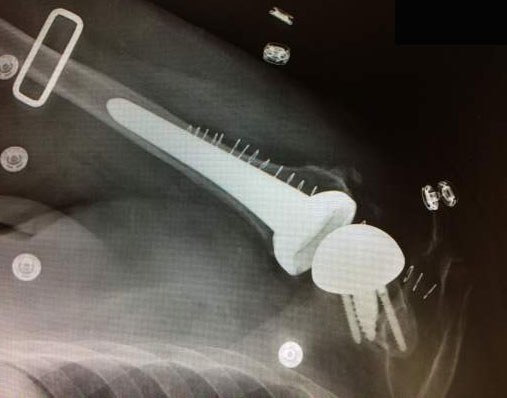The reverse total shoulder is a specially designed type of total shoulder replacement in which the position of the ball and socket joint of the normal shoulder is switched or reversed so that the ball sits where the socket was and the socket is placed where the ball was previously located. The replacement is comprised of three main components – the humeral stem which is a piece of metal which rests in the arm bone similar to the stem of a total hip replacement. The second component is called the glenosphere. This is the ball component of the reverse total shoulder replacement and it is placed where the socket was located. The socket of the shoulder is called the glenoid. The glenosphere baseplate is fixed to the glenoid bone with special screws to ensure that it is stable. The glenosphere ball is then attached to the baseplate and secured with a special locking screw. In between the glenosphere and the humeral stem lies the polyethylene plastic insert. This component allows smooth motion in between the humeral stem and glenosphere.
There are various reasons to perform a reverse total shoulder instead of a standard total shoulder replacement. One main indication to perform a reverse total shoulder replacement is advanced shoulder arthritis in a patient with a massive rotator cuff tear which is not repairable. Standard total shoulder replacement is not appropriate in this scenario because the outcome of this surgery relies on an intact rotator cuff to function properly. Conversely, the design of a reverse total shoulder accommodates for the lack of rotator cuff function. It allows the patient to move their arm and regain function by relying on the deltoid muscle instead of the rotator cuff to move the arm and shoulder. Other reasons to perform a reverse total shoulder include a severe fracture of the shoulder or a fracture dislocation of the shoulder. A reverse total shoulder can also be used as a salvage procedure for failed total shoulder replacement because of implant loosening, rotator cuff tear or fracture around the implants.
The surgery is routinely performed under general anesthesia meaning the patient is put to sleep and intubated. A supplemental injection of local anesthetic placed around the main nerve collection of the arm called the brachial plexus is routinely used as well. This injection, called a scalene block, provides anesthesia to the entire arm for up to 12 hours after the surgery. Patients spend one night in the hospital and are discharged home the next day with a protective arm sling. Patients may shower at home and begin simple passive motion exercises to initiate the rehabilitation process. Patients are then seen in the office two weeks after surgery for staple removal from the incision and a post-operative X-ray to check the position of the shoulder replacement. Patients are then referred to supervised physical therapy where they begin more aggressive exercises for range of motion and strengthening of the shoulder. Full recovery from this surgery is typically in the range of three to six months.





